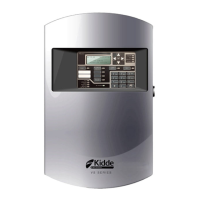Chapter 5: Diagnostics, maintenance, and testing
P/N 3102351-EN • REV 005 • ISS 28DEC18 177
Panel door key
Sound level meter
• A complete check of installed field wiring and devices should be made at regular intervals
in accordance with NFPA 72, Canadian Electrical Code Part I, ULC-S524, and ULC-S536
requirements. This includes testing all alarm and supervisory initiating devices and circuits
and any off-premises connections.
• Panel operation should be verified in the alarm, supervisory, and trouble modes.
• To ensure that the panel can operate correctly when primary power is lost, the batteries
should be inspected and tested periodically. Batteries should be replaced (at a minimum)
every four years.
Canadian tests for grounds, opens, and shorts
ULC requires that you test ground fault, open circuit, and short circuit indications.
For ground fault tests, short one leg of the circuit to chassis ground and verify that the system
Ground Fault LED and Trouble LEDs turn on.
For NAC open circuit tests, remove the end-of-line resistor from the last device on the circuit
and verify that the system Trouble LED turns on.
For NAC short circuit testing, place a short across the NAC output terminals and verify that the
system Trouble LED turns on.
For AUX power short circuit testing, place a short across the AUX power output’s plus (+) and
minus (−) terminals and verify that the system Trouble LED turns on.
For annunciator communications testing, place a short across channel 1
(+ and −) and verify that the system Trouble LED turns on. Repeat for channel 2.
Electronic testing of a device (test fire)
A test fire is a test activation of a smoke or heat detector or input module. A test fire can be
conducted to test for proper operation of a detector or input module and its programming.
When a detector is test fired, the panel sends a command to the detector at which time the
detector simulates a smoke or heat buildup, causing an actual activation of the detector. When
an input module is test fired, the panel sends a command to the module causing the module to
simulate an activation (alarm, supervisory, or monitor).
Notes
• A test fire is not an equivalent substitute for required functional testing per NFPA 72. In all
cases, the manufacturer's documented testing procedures should be followed in
accordance with all applicable codes, standards, and methods approved by the AHJ
• NAC responses activate as programmed.

